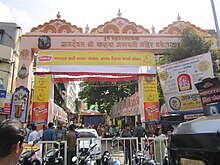This article needs additional citations for verification. (April 2024) |
Kasba Peth or Kasba[citation needed] is the oldest[citation needed] residential part, "Peth " (locality), in Pune, India.[1] It is adjacent to the historic Shaniwar Wada palace-fort. Kasba Peth was the first Peth to be established sometime during the 5th century, and is the oldest area in Pune. It is called the "Heart of Pune City". In the history of Pune, the city was once known as "Kasbe Pune".

Kasba Ganapati is the Gram Devta of Pune. It was built during Shivaji's reign. Lal Mahal, the fortified residence of Shivaji, was situated in Kasba Peth. Today, its replica can be seen adjacent to Shaniwarwada. Being the oldest part of the City, old residential complexes, "Wada (house)", exist here. Kasba Peth is primarily a residential area. A wide variety of shops surround Kasba Peth (Tambat Ali, Shimpi Ali, Vyavahar Ali, Bhoi Ali, etc.). It is well known for the Kumbhar Wada (area of earthen potmakers) and the Tambat Ali (area of brass/copper utensil manufacturers).
History
editAncient history
editIn 2003, an accidental discovery of artefacts from the Satvahana period in the Kasba peth area of Pune has put the origin of settled life in the area to the early part of the first millennium.[2][3] Traditional accounts state that the temples of Puneshwar and Narayaneshwar were turned into the Sufi shrines of Younger Sallah and Elder Sallah respectively during early islamic rule in the 1300s.[4] There is a story about the Kasba Ganpati: Some children had brought cows to the area for grazing, and found an idol of Ganapati. Then, they colored this idol and started worshipping it. Shivaji's mother Jijabai also visited the temple often. Hence, Dadoji Konddeo built a pendol in front of the idol; this is where the Kasba Ganpati Temple is located today.
Business and Amenities
editplaces of worship
editHindu temples
edit- Kasba Ganapati Temple : This is the village deity of Pune.
- Tvashta Kasar Devi Temple: This goddess is considered as the goddess of Kasar society.
- Trimbakeshwar Temple
- Puneshwar Maruti Temple
- Gavkos Maruti Temple
Shaikh Sallah Dargah
editThe 14th century shrine, which came to be known as Dhakta Shaikh Salla Dargah, along with Thorla Shaikh Salla Dargah, has been among the popular religious places in Pune over the centuries.[5]
Businesses
editThe part of the Peth near the Mutha river is known as Kumbhar Wada (locality of the earthen pot makers). Skilled metal craftsmen (known as Tambat) known for crafting utensils out of brass and copper also reside there.There is also a tailor's lane in the peth.
Places of interest
edit- Lal Mahal
- Sat toti Houd
References
edit- ^ https://geoiq.io/places/Kasba-Peth/Qc1sWlPwZJ
- ^ Gautam Sengupta; Sharmi Chakraborty; B.C. Deotare, Sushma Deo, P.P. Joglekar, Savita Joglekar, S.N. Rajguru (2008). "3, Early historic sites in Western India". The Archaeology of Early Historic South Asia. New Delhi, India: Pragati Publications in association with Centre for Archaeological Studies and Training. p. 87. ISBN 978-1-316-41898-7.
{{cite book}}: CS1 maint: multiple names: authors list (link) - ^ JOGLEKAR, P. P., et al. “A NEW LOOK AT ANCIENT PUNE THROUGH SALVAGE ARCHAEOLOGY (2004-2006).” Bulletin of the Deccan College Research Institute, vol. 66/67, 2006, pp. 211–25. JSTOR, http://www.jstor.org/stable/42931448 Archived 6 June 2022 at the Wayback Machine. Accessed 6 Jun. 2022.
- ^ Gadgil, D. R. (1945). Poona A Socio-Economic Survey Part I. Pune, India: Gokhale Institute of Politics and Economics. p. 13. Archived from the original on 10 November 2023. Retrieved 28 July 2020.
- ^ https://www.hindustantimes.com/cities/pune-news/dhakta-shaikh-salla-dargah-trustees-agree-to-demolish-unauthorised-construction-101710011618036.html